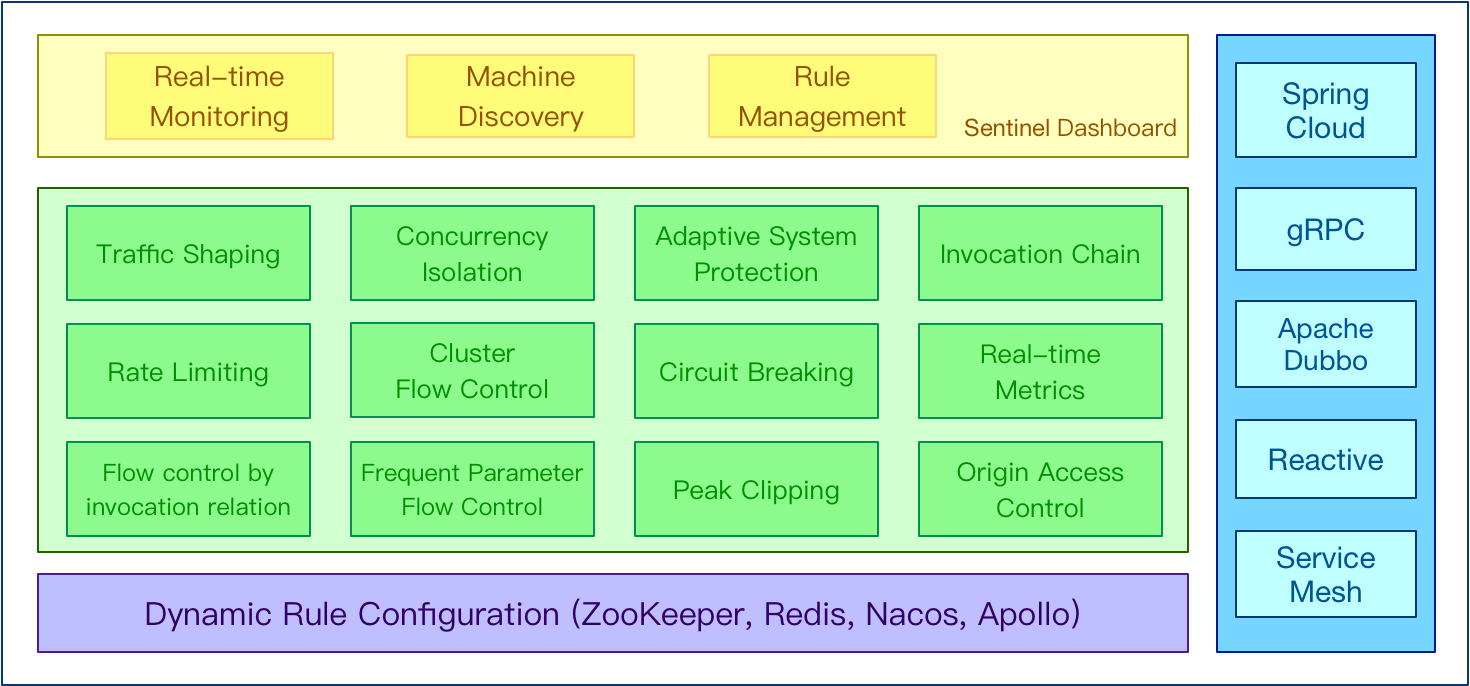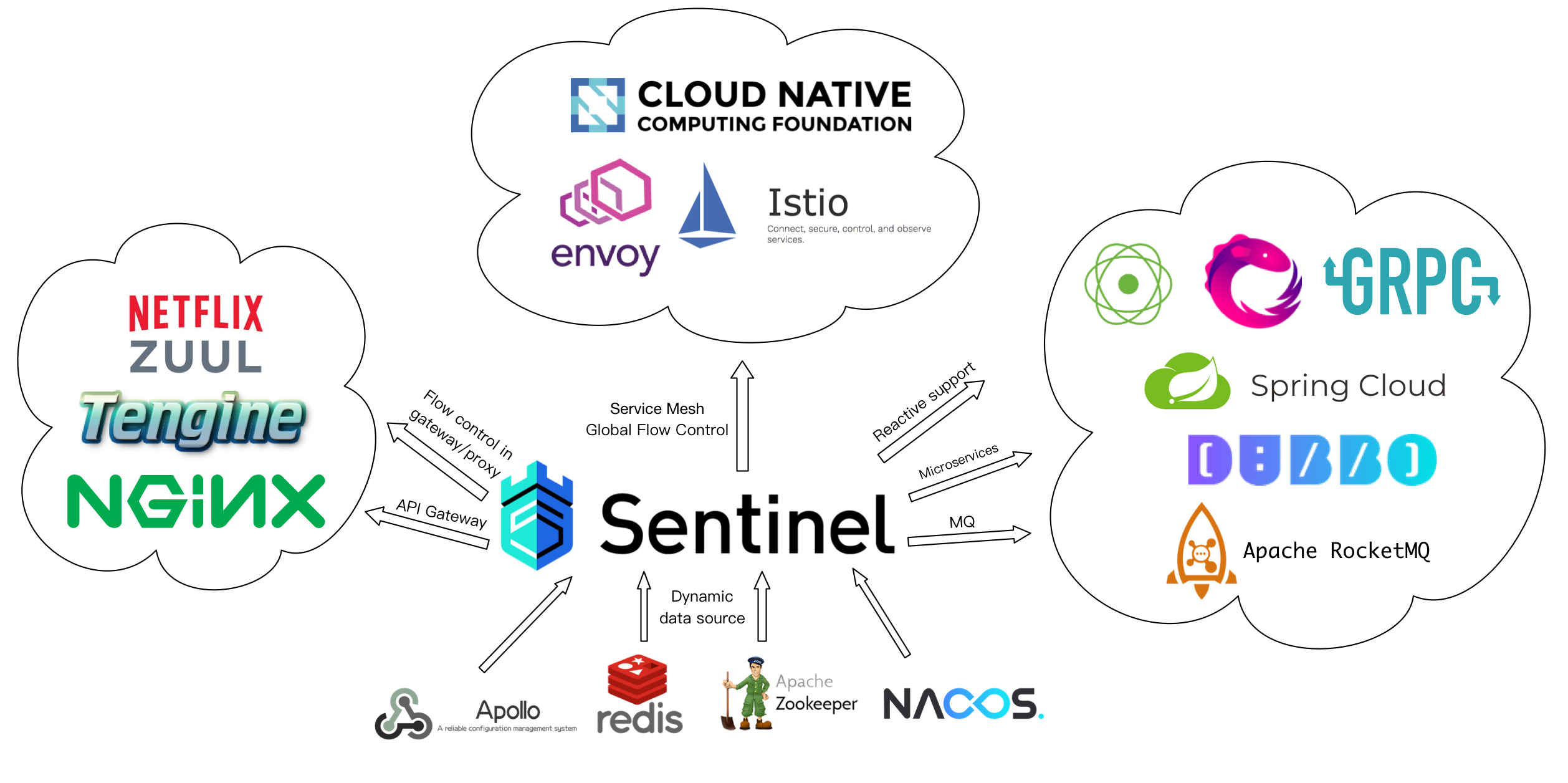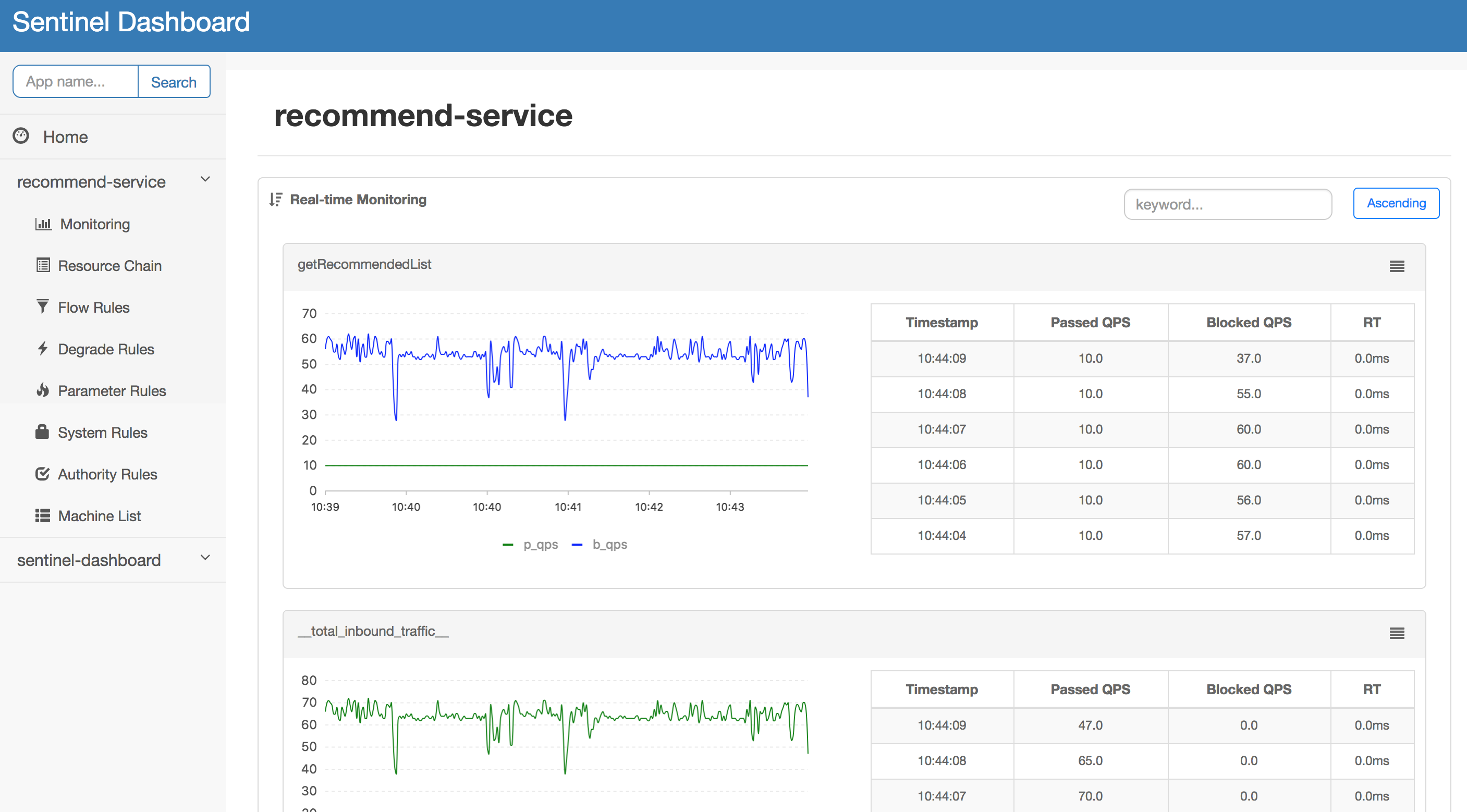|
|
pirms 5 gadiem | |
|---|---|---|
| .circleci | pirms 5 gadiem | |
| .github | pirms 6 gadiem | |
| doc | pirms 5 gadiem | |
| sentinel-adapter | pirms 5 gadiem | |
| sentinel-benchmark | pirms 5 gadiem | |
| sentinel-cluster | pirms 5 gadiem | |
| sentinel-core | pirms 5 gadiem | |
| sentinel-dashboard | pirms 5 gadiem | |
| sentinel-demo | pirms 5 gadiem | |
| sentinel-extension | pirms 5 gadiem | |
| sentinel-transport | pirms 5 gadiem | |
| .codecov.yml | pirms 5 gadiem | |
| .gitignore | pirms 6 gadiem | |
| .travis.yml | pirms 5 gadiem | |
| CODE_OF_CONDUCT.md | pirms 6 gadiem | |
| CONTRIBUTING.md | pirms 6 gadiem | |
| LICENSE | pirms 6 gadiem | |
| README.md | pirms 5 gadiem | |
| pom.xml | pirms 5 gadiem | |
README.md

Sentinel: The Sentinel of Your Microservices
Introduction
As distributed systems become increasingly popular, the reliability between services is becoming more important than ever before. Sentinel takes “flow” as breakthrough point, and works on multiple fields including flow control, circuit breaking and system adaptive protection, to guarantee reliability of microservices.
Sentinel has the following features:
- Rich applicable scenarios: Sentinel has been wildly used in Alibaba, and has covered almost all the core-scenarios in Double-11 (11.11) Shopping Festivals in the past 10 years, such as “Second Kill” which needs to limit burst flow traffic to meet the system capacity, message peak clipping and valley fills, circuit breaking for unreliable downstream services, cluster flow control, etc.
- Real-time monitoring: Sentinel also provides real-time monitoring ability. You can see the runtime information of a single machine in real-time, and the aggregated runtime info of a cluster with less than 500 nodes.
- Widespread open-source ecosystem: Sentinel provides out-of-box integrations with commonly-used frameworks and libraries such as Spring Cloud, Dubbo and gRPC. You can easily use Sentinel by simply add the adapter dependency to your services.
- Various SPI extensions: Sentinel provides easy-to-use SPI extension interfaces that allow you to quickly customize your logic, for example, custom rule management, adapting data sources, and so on.
Features overview:
Documentation
See the 中文文档 for document in Chinese.
See the Wiki for full documentation, examples, blog posts, operational details and other information.
Sentinel provides integration module for various open-source frameworks and libraries (e.g. Spring Cloud, Apache Dubbo, gRPC, Spring WebFlux, Reactor). You can refer to the document for more information.
If you are using Sentinel, please leave a comment here to tell us your scenario to make Sentinel better. It’s also encouraged to add the link of your blog post, tutorial, demo or customized components to Awesome Sentinel.
Ecosystem Landscape
Quick Start
Below is a simple demo that guides new users to use Sentinel in just 3 steps. It also shows how to monitor this demo using the dashboard.
1. Add Dependency
Note: Sentinel requires Java 7 or later.
If your application is build in Maven, just add the following dependency in pom.xml.
<!-- replace here with the latest version -->
<dependency>
<groupId>com.alibaba.csp</groupId>
<artifactId>sentinel-core</artifactId>
<version>1.6.3</version>
</dependency>
If not, you can download JAR in Maven Center Repository.
2. Define Resource
Wrap your code snippet via Sentinel API: SphU.entry(resourceName).
In below example, it is System.out.println("hello world");:
try (Entry entry = SphU.entry("HelloWorld")) {
// Your business logic here.
System.out.println("hello world");
} catch (BlockException e) {
// Handle rejected request.
e.printStackTrace();
}
So far the code modification is done. We also provide annotation support module to define resource easier.
3. Define Rules
If we want to limit the access times of the resource, we can set rules to the resource. The following code defines a rule that limits access to the resource to 20 times per second at the maximum.
List<FlowRule> rules = new ArrayList<>();
FlowRule rule = new FlowRule();
rule.setResource("HelloWorld");
// set limit qps to 20
rule.setCount(20);
rule.setGrade(RuleConstant.FLOW_GRADE_QPS);
rules.add(rule);
FlowRuleManager.loadRules(rules);
For more information, please refer to How To Use.
4. Check the Result
After running the demo for a while, you can see the following records in ~/logs/csp/${appName}-metrics.log.{date} (When using the default DateFileLogHandler).
|--timestamp-|------date time----|-resource-|p |block|s |e|rt |occupied
1529998904000|2018-06-26 15:41:44|HelloWorld|20|0 |20|0|0 |0
1529998905000|2018-06-26 15:41:45|HelloWorld|20|5579 |20|0|728 |0
1529998906000|2018-06-26 15:41:46|HelloWorld|20|15698|20|0|0 |0
1529998907000|2018-06-26 15:41:47|HelloWorld|20|19262|20|0|0 |0
1529998908000|2018-06-26 15:41:48|HelloWorld|20|19502|20|0|0 |0
1529998909000|2018-06-26 15:41:49|HelloWorld|20|18386|20|0|0 |0
p stands for incoming request, block for blocked by rules, success for success handled by Sentinel, e for exception count, rt for average response time (ms), occupied stands for occupiedPassQps since 1.5.0 which enable us booking more than 1 shot when entering.
This shows that the demo can print “hello world” 20 times per second.
More examples and information can be found in the How To Use section.
The working principles of Sentinel can be found in How it works section.
Samples can be found in the sentinel-demo module.
5. Start Dashboard
Sentinel also provides a simple dashboard application, on which you can monitor the clients and configure the rules in real time.
For details please refer to Dashboard.
Trouble Shooting and Logs
Sentinel will generate logs for troubleshooting and real-time monitoring. All the information can be found in logs.
Bugs and Feedback
For bug report, questions and discussions please submit GitHub Issues.
Contact us: sentinel@linux.alibaba.com
Contributing
Contributions are always welcomed! Please see CONTRIBUTING for detailed guidelines.
You can start with the issues labeled with good first issue.
Credits
Thanks Guava, which provides some inspiration on rate limiting.
And thanks for all contributors of Sentinel!
Who is using
These are only part of the companies using Sentinel, for reference only. If you are using Sentinel, please add your company here to tell us your scenario to make Sentinel better :)


















